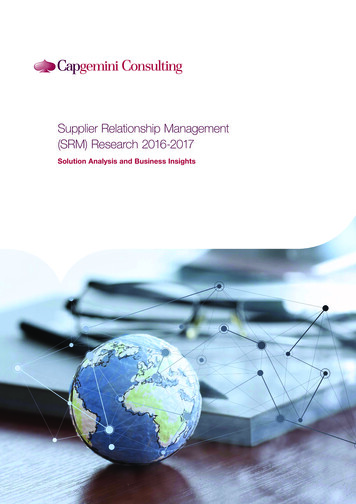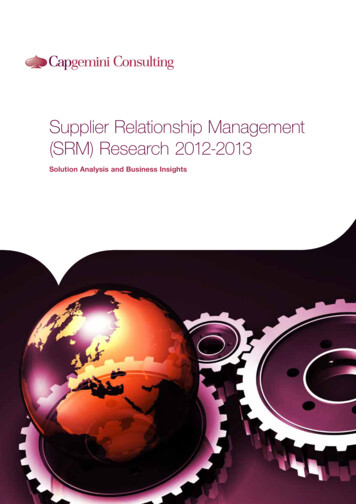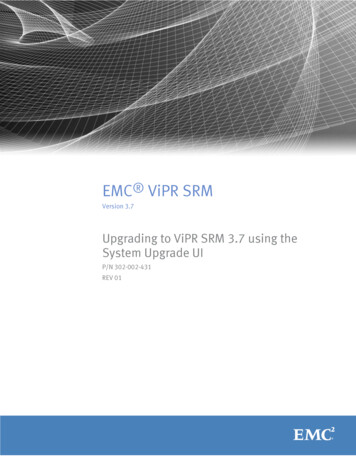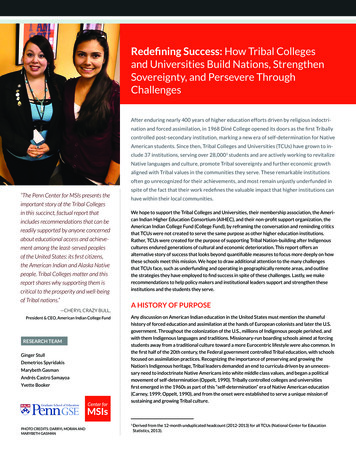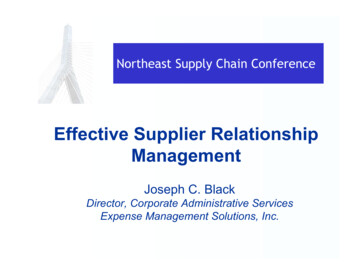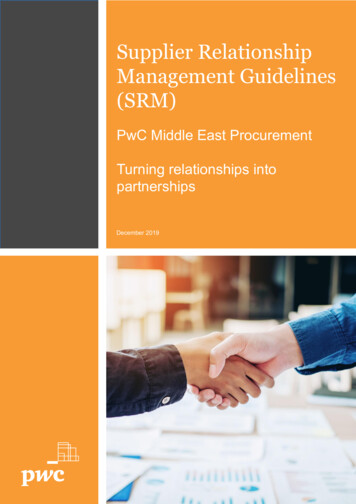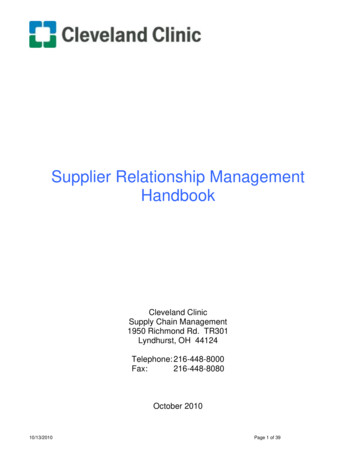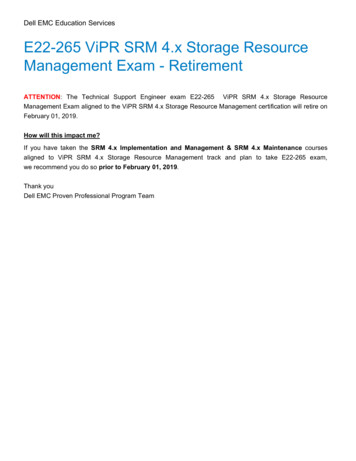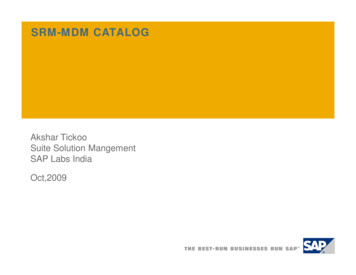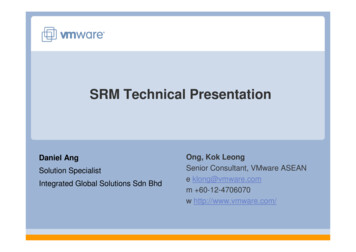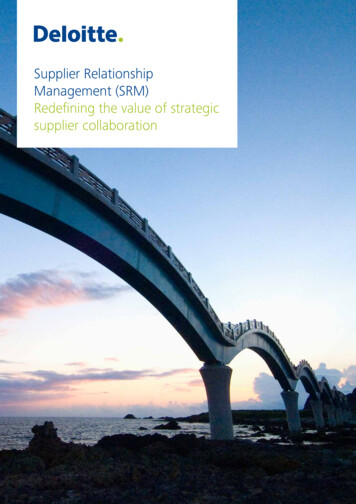
Transcription
Supplier RelationshipManagement (SRM)Redefining the value of strategicsupplier collaboration
As today’s integrated supply chains require collaborationat many levels and from various functions, executivesare increasingly looking for innovative ways to leverageexisting and new supplier relationships for theirexpansionary pursuit. Supplier Relationship Management(SRM) is one approach to connect the different interestsboth within the organization and with the extendedsupply chain. SRM identifies and engages the rightstakeholders to create ownership of the relationship,drive effective communication and align strategicobjectives. The result is a foundation for continuousefficiency improvements, such as cost reductions, riskmitigation or improved go-to-market times just as wellas improved potential for disruptive innovation.34% of global CPOs plan toincrease their levels of suppliercollaboration in 2015Deloitte’s Global CPO Survey 2014 found increasinglevels of supplier collaboration and restructuring ofexisting relationships among the top procurement levels.While in some industries 77% of CPOs may be activelydriving innovation with suppliers, the vast majority ratesthe effectiveness of their strategic supplier collaborationsas poor or mixed.In this article we examine the need to look beyondtraditional Procurement-centric perspectives on suppliermanagement, explore how relationships with keypartners should be managed in a strategic and holisticmanner and provide high-level guidelines on how andwhere to get started with SRM.Traditional perspectives on supplier managementare lacking a clear framework and alignmentMany organizations struggle to manage their supplierrelationships systematically. The main reason behind thisis their lack of a clear framework with aligned guidelineson supplier management. In traditional supplierrelationships the interaction between different functionsof a company and its suppliers can be described astactical and operational. As a result relationshipsare lacking transparency not only from an externalperspective, but also with respect to internal governanceand ownership of relationships. This effect is furtheramplified by the organizations’ growth and acquisition2strategies, which may lead to a growing supply network,increasingly global operations and raises the level oforganizational complexity and risk. The ensuing myriadof internal and external stakeholders likely creates avulnerable network with little global visibility.Applying a thorough SRM approach successfulrelationships arise from companywide commitmentscombined with a clearly defined process. Strategicsupplier relationships comprise multiple, yet controlledpoints of interaction between various representativesof the organization and its key suppliers. The alignmentof supplier relationships across the organizationrequires a clear governance structure, both within theorganisation and towards their strategic suppliers,standardized performance measurements and corporatesupplier strategies. A clear framework to managesupplier relationships at different levels and in differentfunctions reduces the level of complexity and increasestransparency internally as well as externally.Executives are acutely becoming aware of thesedrivers; future-proofing business through sustainablecollaboration with suppliers becomes imperative.Importance of business partnering with other membersof the C-suite from the CPO urce: The Deloitte Global CPO Survey 2014Establish mutually beneficial relationships withkey suppliersThe main objective of Supplier RelationshipManagement (SRM) is to establish two-way, mutuallybeneficial relationships between an organization and itssuppliers. It consists of collaborative and relationshipbuilding activities targeted at the most strategic andcritical supply partners that deliver great added valueto the firm (e.g. in terms of sustained competitiveadvantage or innovation). Thereby SRM activities areadditional and complementary to supplier performanceand contract management activities which are targetedat the majority of suppliers.
We are seeing a number of benefits that companiesderive from successfully managing SRM: Reduce costs and increase efficiency beyondtraditional sourcing and category management effortsby setting up long-term relationships and establishcommunication processes Manage supplier risk and compliance by strengtheningglobal transparency and visibility on key relationshipsthrough policies and processes, metrics and tools Drive supplier performance in a transparent andsustainable manner with strategic suppliers andcollaboration partners Enable continuous improvement of operationsthrough long-term relationships with suppliers,allowing for the creation of a more effective andefficient supply chain Foster business development and innovation by jointlyidentifying and implementing innovation and newmarket opportunities, sharing vision and strategythrough joint planning early on to improve go-tomarket timeCreate sustainable value with SRM processesTo enable an organization to drive more value out oftheir supplier relationships SRM is organized around aset of core complementary processes. These processesfocus on supplier segmentation, SRM governance,supplier performance management, and supplierdevelopment.Continuous cycle of Supplier Relationship DevelopmentSource: Deloitte ConsultingPerformanceManagementSupplier segmentationSupplier segmentation is the process of categorizingsuppliers based on a defined set of criteria in orderto identify the key (strategic) suppliers with which toengage in SRM. This selection process is importantas not all suppliers require the same level of focus.Organizations should therefore concentrate theirresource allocation and spend their time and efforts on alimited number of relevant strategic suppliers (priority 1).Segmented supplier base and prioritized focus groupPriority 1suppliersPriority 2suppliersPriority 3suppliersSource: Deloitte ConsultingThe criteria along which these relationships areprioritized are typically spend and business criticality.They need to reflect the strategic importance of thesupplier to the organization. The segmentation processis a prerequisite to set up effective governance withstrategic suppliers.SRM governanceEstablishing effective governance is key to unlockingSRM value, especially for priority 1 suppliers. Aprerequisite to this is the alignment within theorganization, the setup of internal governanceprocesses and clearly assigned ownerships of supplierrelationships. The ownership of the relationship can beoutside of the Procurement organization, therefore itis essential to involve the right stakeholders from thebusiness in the process. These stakeholders are partof a formal supplier governance committee for eachpriority 1 supplier. A governance committee for examplecan define and drive the strategic roadmap togetherwith the supplier. Top-level strategic objectives witheach priority 1 supplier are to be mutually agreed atthe top level on both sides (in top-to-top meetings).3
These objectives are essential in driving the setup ofoperational measures and metrics to be monitored aspart of the performance management process.Involved stakeholder interaction across ontact pointsSuppliercontact urce: Deloitte ConsultingPerformance managementPerformance management is a prerequisite for effectiveSRM. It involves the setup and continuous tracking ofoperational measures which are mutually agreed withpriority 1 suppliers. It focuses on the “critical few”measures, which are consolidated on a single supplierscorecard. Subsequently it enables a global, sharedview of supplier performance along a common set ofdefined metrics which should be cascaded down theorganization (local, regional, global levels).Once in place, the supplier scorecard needs to becontinuously monitored and review meetings shouldbe regularly held with strategic suppliers. Any deviationfrom agreed minimum performance requirementsshould be addressed immediately by identifying the rootcause and putting in place corrective measures.Supplier developmentSegmentation, governance and performancemanagement are cornerstone components of SRM.Once in place they represent a springboard to additionalvalue creation activities that can be undertakenwith strategic suppliers. Joint business developmentbetween an organization and its priority 1 suppliers isan example of those additional activities that can bederived from SRM. This would typically involve sharingof plans between the two entities and defining longterm initiatives, such as market penetration, mergers,acquisitions and joint ventures, or strategic alliances.4Supplier innovation management provides the rightinnovation platform as well as guidelines to ensureappropriate feedback and follow-up on innovationproposals from suppliers.Ensure conformance with supplier audits tomanage supply risksMany companies are exposed to reputationaland regulatory risks through their complex supplxchains. Especially with strategic suppliers in scopeof SRM supplier audits are a key activity allowingfor identification of non-conformances with anorganization’s values, standards, laws and regulations inthe following categories:Financial stability and business continuityConformance with financial requirements, liquidity anddebt ratios; ability to manage crisis and ensure supplycontinuity;Compliance to legal, quality and valueCompliance with sustainability, safety and labourstandards and conformance with applicable laws andregulations;Traceability of products and servicesConformance with declaration guidelines and trackingrequirements throughout the supply chainOvercome challenges of establishing SRMDespite the various benefits of SRM, establishingstrategic collaboration with key suppliers can be highlychallenging. In the normal course of events supplierrelationships are exposed to stress and strain so thatmutual expectations might not be met unless bothparties are thoroughly committed to success. Thefollowing 5 key steps help organizations to overcomethese challenges in order to successfully build strategicrelationships with their suppliers.1. Select the right partnersWhen segmenting the supplier base, look beyondstrategic and financial fit and consider differencesin corporate culture, operating model, and businesspractices as well. Additionally, think of what tomorrow’scompetitive advantage could be and which supplierscould support it.
2. Align internally and externallyAchieve a clear alignment with business stakeholdersacross all levels, as well as an understanding ofrequirements and existing initiatives within and outsidethe organization. Shift your focus towards the extendedsupply chain, assessing and judging cause and effectnot only for your own company, but across the entirenetwork of strategic suppliers.to as “Voice of the Supplier (VoS)” survey, it helpsanswer questions such as: What does the market thinkabout us? What do suppliers identify as key strengthsand opportunities in working with us? Repeated on anannual basis, the survey provides an excellent basis tomeasure the progress of SRM from the perspective ofthe supply base.3. Establish mutually beneficial relationshipsWhen negotiating with your strategic suppliers, makesure that you negotiate a win-win deal for bothparties, considering immediate actions as well as futureengagements. Foster collaboration by training youremployees in conflict management, problem solving,and networking skills.Only 39% of CPOs activelydrive innovation initiativeswith their suppliers4. Select meaningful KPIs and share informationSelect measures that are relevant to your supplier’s andyour own business based on your mutually definedstrategic objectives and be specific on how thosegoals should be measured. Communicate openly andcontinuously and ensure information flows in bothdirections on a real-time basis.Case study: SRM enhancements at GlobalConsumer Business CompanyDeloitte was asked to support the client’s SRMenhancement initiative which they started internally.Based on an initial gap assessment, Deloitte followeda combined approach of both mobilizing internalstakeholders and conducting an external Voice of theSupplier (VoS) survey.5. Commit to changeRecognize that entering any strategic supplierrelationship will result in changes within each partnerorganization and that mutual commitment to ongoing,incremental change is required.Move from Strategy to ActionOnce a company has overcome initial internal hurdlesto realize their SRM vision there are two common, nonmutually exclusive ways to get started: starting internallyby identifying and mobilizing key stakeholders, orconducting an external survey with key suppliers.Identifying and mobilizing key stakeholders: Typicallythese are individuals working on different topics withstrategic suppliers, such as the Planning department,Purchasing or Quality Management. Existingcommunication matrices can be a good starting pointto identify important internal stakeholders. Havingidentified and assessed all internal relationships, it istime to decide on a dedicated responsible to coordinateand manage all activities from a neutral, end-to-endperspective moving forward.Conducting a survey among the main actors within thecompany’s supply base can also be a great enhancer tothe SRM strategy and support its deployment. ReferredTogether with a core team from the client, Deloittedeveloped a framework for the client’s SRM approachincluding the following: Agreement on SRM strategy Definition of supplier segmentation process and tools Establishment of a governance model and definitionof roles and responsibilities, for both internally andexternally Improvements and guidance to the performancemanagement process and measu
Supplier Relationship Management (SRM) is one approach to connect the different interests both within the organization and with the extended supply chain. SRM identifies and engages the right stakeholders to create ownership of the relationship, drive effective communication and align strategic objectives. The result is a foundation for continuous efficiency improvements, such as cost .
